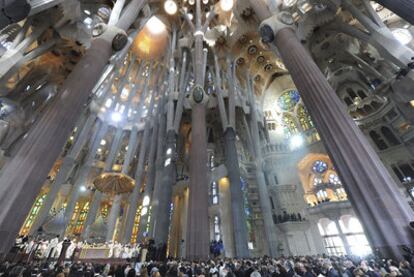How wrong could we be?
Architect and designer Oscar Tusquets wishes to apologize for a controversial 1960s manifesto
In the early 1960s, while still a student, I was one of the instigators of a manifesto that opposed continuing work on the Sagrada Familia in Barcelona. The text was unconditionally supported by the entire intelligentsia of the period, from Bruno Zevi to Julio Carlo Argan, Alvar Aalto and Le Corbusier. Although its publication triggered a strong reaction and construction work resumed with renewed vigor, we remained convinced that this was a mistake of monumental proportions.
But now the pope has consecrated the temple, it's time to reconsider. My doubts actually began when I saw the majestic central nave going up. My rejection took an even bigger hit when Alfons Soldevila, an excellent architect, assured me that if only I got to know the temple in depth, I would change my mind. He said this was the most important building in the 20th century, and was willing to prove it. So I visited the temple from the bottom up (over 60 meters in height), and I was left speechless.
The biggest problem is finding contemporary artists able to carry out Gaudí's projects
It is true that in the areas that Gaudí left unspecified, there are two serious problems: one is that the people who carried on the project lacked the talent to interpret Gaudí using his own language or to enter into a dialogue with him. This means that nearly all the details added after his death are an eyesore: stainless steel and glass handrails, harsh lighting, pavements, glass windows and in general, decorative elements that fail to live up to the structure as a whole. Still, these details do not take away from the immense quality of the monument, and could even be replaced in a desirable future.
The second, more serious problem is the challenge of finding contemporary artists able to carry out the maestro's figurative projects. Gaudí meant to imitate medieval cathedrals by explaining the Holy Scriptures on the cathedral's façade. This was no easy task in the early 20th century, but Gaudí's genius came up with a solution that was borderline kitsch: the Fachada del Nacimiento features walls that wrinkle up to form figures, many of which were obtained using molds of real people and animals. The painful result on the Fachada de la Pasión reveals the true difficulty of pursuing this line of work. And there is still the main wall, the Fachada de la Gloria, left to do.
But our main objection to continuing the project was the fact that we did not know what Gaudí would have done, since he used to improvise and his blueprints were destroyed at the beginning of the Civil War. Any re-interpretation would amount to a betrayal, we thought. If project leaders had listened to us 50 years ago, this marvel would not exist in its present state. How many people would visit it? This temple never had economic support from the institutions; instead it lives off the donations of its two million yearly visitors. It is being financed like a true medieval cathedral. I don't know if the completed work will be the best architectural project of the last century... but it will certainly be the greatest religious building of the last three.

Tu suscripción se está usando en otro dispositivo
¿Quieres añadir otro usuario a tu suscripción?
Si continúas leyendo en este dispositivo, no se podrá leer en el otro.
FlechaTu suscripción se está usando en otro dispositivo y solo puedes acceder a EL PAÍS desde un dispositivo a la vez.
Si quieres compartir tu cuenta, cambia tu suscripción a la modalidad Premium, así podrás añadir otro usuario. Cada uno accederá con su propia cuenta de email, lo que os permitirá personalizar vuestra experiencia en EL PAÍS.
¿Tienes una suscripción de empresa? Accede aquí para contratar más cuentas.
En el caso de no saber quién está usando tu cuenta, te recomendamos cambiar tu contraseña aquí.
Si decides continuar compartiendo tu cuenta, este mensaje se mostrará en tu dispositivo y en el de la otra persona que está usando tu cuenta de forma indefinida, afectando a tu experiencia de lectura. Puedes consultar aquí los términos y condiciones de la suscripción digital.
Últimas noticias
The metaverse, four years later: Is it finished or just at a standstill?
$3,000 and a plane ticket: The United States increases incentives for migrants to self-deport before the end of the year
Charles Dubouloz, mountaineering star, retires at 36 with a farewell tour inspired by Walter Bonatti
From the White House to diplomatic gifts: Lego wins over adult fans, brick by brick
Most viewed
- Families demand repatriation of bodies of Colombians who died in Ukraine: ‘This war is a slaughterhouse for foreigners’
- The low-cost creative revolution: How technology is making art accessible to everyone
- Liset Menéndez de la Prida, neuroscientist: ‘It’s not normal to constantly seek pleasure; it’s important to be bored, to be calm’
- Christian Louboutin: ‘Young people don’t want to be like their parents. And if their parents wear sneakers, they’re going to look for something else’
- Christmas loses its festive spirit: ICE fears cast shadow over religious celebrations








































